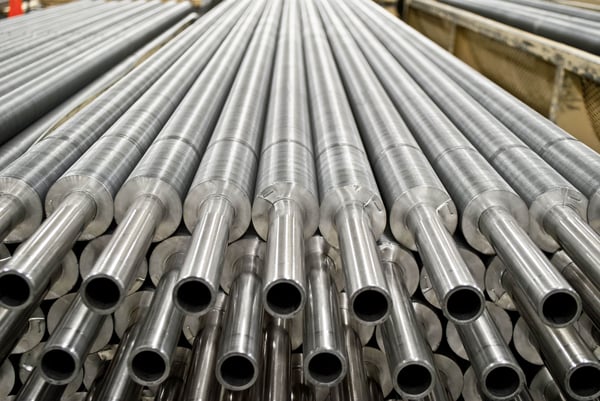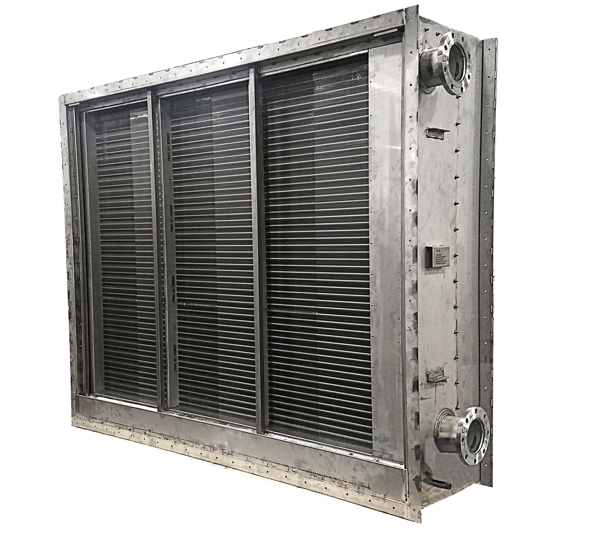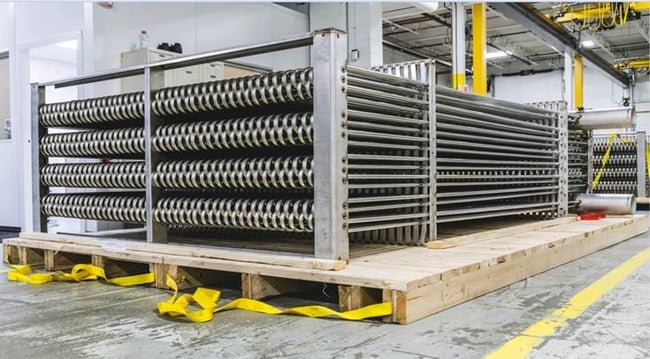In the heat transfer universe, the term ‘coil’ is typically used to describe lighter duty heat exchangers used for various HVAC-R functions across a slew of industries. However, when the pressures, temperatures, and all-around harshness of an application and installation environment are ratcheted up, this equipment commonly falls under the ‘industrial heat exchanger’ umbrella.
This term describes heat exchangers made with more robust materials, thicker gauges/walls, and overall higher levels of engineering. These heat exchangers can take a number of forms, and for the purposes of this post, we thought we’d run through some popular designs and configurations, the reasons behind their appearance, and some industries that commonly make use of such equipment. Specifically, we’ll be addressing spiral wrapped fin heat exchangers and industrial fin and tube heat exchangers.
Spiral wrapped fin heat exchangers
Materials
In this type of heat exchanger, each tube is outfitted with its own spiral fin for the length of the tube, an example of which is pictured below. The tube/fin bundles in this type of heat exchanger tend to be steel (carbon, stainless, etc.), but can also be made of copper if required by the application.

One important difference between industrial plate fin heat exchangers and spiral wrapped is the means by which the fin and tube are mechanically bonded. For more information on spiral fin heat exchangers here.
In a spiral fin construction, the fin is typically attached to the tube in one of three ways: edge-wound, wrap-on or L-footed, and embedded, which are explained below.
Edge wound – a strip of fin material is wound onto the tube in a perpendicular orientation, creating a continuous spiral fin along the length of the tube. The fin and tube are bonded by tension.
Wrap-on or “L”- footed – a strip of a fin material is would onto the tube in such a way that part of the fin strip bends 90° lays down parallel to the tube, creating a “foot.” This foot increases the fin contact area with the tube, providing additional heat transfer. This method also relies on a tension bond.
Embedded: For this method, a groove is plowed on the surface of the tube and the fin strip is wound into the groove. The groove’s edges are pushed back down over the edge of the fin to lock the fin in place. This method makes the tube material itself bond with the fin, a bond that is maintained even in high temperature applications.
Applications
The list below contains some examples of where you might see spiral wrapped heat exchangers.
- Air preheaters
- Fluidized bed dryers
- Waste heat recovery heat exchangers
- Economizers
Industrial plate fin heat exchangers
This type of industrial heat exchanger resembles its lighter duty commercial HVAC brethren in appearance. They consist of tubes inserted through a series of metallic “fins.” These fins are made using a continuous roll of metal sheet which is fed through a press that punches holes for tubes and cuts the sheet to size.
To accomplish this, presses use several different types of dies, which allow for variable configurations of fins per inch (FPI), tube to tube spacing and tube diameter. The tubes are inserted through the fin pack, at which point the two will mechanically bonded together using either pressurized water or with a pneumatic machine that passes a bullet through the tube and expands it to fit tightly against the fins. This step is critical for maximizing the heat transfer between the air and fin side.
That appearance is largely the same for both light duty HVAC coils and industrial plate fin heat exchangers, with the materials of construction and usually overall size being the main differentiators.

Materials
Due to the higher temperatures and pressures present in industrial environments, industrial plate fin heat exchangers tend to be built using steel tubes (carbon, stainless, superalloys, etc.) rather than copper ones, as well as thicker gauges of aluminum fin material or different fin material, such as copper, carbon steel, and stainless steel. Fins come in a number of configurations, aimed at increasing heat transfer performance.
Using materials like stainless steel helps protect against corrosion, but some applications of spiral wrapped heat exchangers make use of coating for corrosion resistance when materials like stainless steel are cost prohibitive or thermally insufficient. Some examples of these coatings are E-coat and Heresite P-413.
Additionally, certain applications dictate that heat exchangers be without fins altogether. These bare-tube designs are frequently seen in industries where the airstream contains high levels of particulates, such as fluidized bed drying, pollution abatement and waste heat recovery. Some applications also incorporate a section of bare tubing in the coil in front of the fin pack to minimize contamination in the finned portion of the heat exchanger.

Plate fin heat exchangers in industrial applications also sometimes use some kind of coating, like the two mentioned earlier when corrosion-resistant materials aren’t cost effective or thermally viable, such as this application, for example.
Applications
Below is a list of some places you might see industrial plate fin heat exchangers.
- Power generation applications
- Food storage and processing applications
Industrial heat exchangers can take a number of forms and they exist across a wide spectrum of industries. We hope this piece has been helpful in explaining some of the various designs that exist and the industries in which they’re typically found. To read about the differences between plate fin and spiral wrapped heat exchangers and the unique advantages of each, check out our blog here.
We engineer and manufacture both types of industrial heat exchangers at Super Radiator Coils. If you’re in need of industrial heat transfer equipment, give us a call. Regardless of what design is best suited for your application, we’ll build you the right tool for the job.
Don’t get left out in the cold when it comes to heat transfer information. To stay up to date on a variety of topics on the subject, subscribe to The Super Blog, our technical blog, Doctor's Orders, and follow us on LinkedIn, Twitter, and YouTube.





